Scales are the most important part of learning music. Here is a list of musical scales that are some of the most common scales that you will encounter.
With each scale we have included an image of the scale on the treble clef, an audio file so you can hear how the scale sounds, and the note represented on the piano keyboard.
All scales are made up of a combination of notes that create a scale. Each scale has a set pattern of half steps (semitones) and whole steps (whole tones) that makes the scale. This pattern is useful because once you know the pattern you can then transfer it to any music key.
For example, if you know the pattern for the C Major Scale, you can then transfer that same pattern to the key signature of D Major.
Scale Patterns
Each scale has a pattern of half steps and whole steps. A half step is moving from one note to the note directly next to it. This includes black keys. So, if you start on a C note and move to up a half step you would end up on Db.
A whole step is similar to a half step in that you are moving from one note to another, but here you are moving a total of two half steps. So, if you start on a C note and move a whole step you will end up on D. This is because from C to Db is one half step, and then from Db to D is another half step making a whole step.
List of Musical Scales
Here we have a list of the scales most commonly used. I am going to include each pattern with these scales. So from here on, a Whole Step will be know as WS and a Half Step will be known as HS. So lets get going.
Major Scale
This scale is the one that is most used in contemporary music. It has a very pleasing sound and all the notes seem to resolve to the next. It is really the most well know scale and most used scale.
To make a major piano scale, start on any note (this is called the Root) and then follow this pattern of Whole Steps (WS) and Half Steps (HS)
Root – WS – WS – HS – WS -WS – WS – HS
The final Half Step will end on the root note, an octave from where you started.


Now try using the same pattern as above and make another major scale with a different root note.
Minor Scales
There are three different types of minor scales. Each has a unique sound and a different pattern. These minor scales have a mysterious sound and not all the notes will sound like they are resolving like the notes in the major scale.
Natural Minor
The Natural Minor Scale is the second most common scale in the list of musical scales. It is an enharmonic scale with another major scale.
For example, the enharmonic minor scale for the C Major Scale would be A Minor Scale.
Look at the notes in the A Minor Scale below and you will see that it has the same notes as the C Major scale you just start on a different root note.
The pattern for the Natural Minor Scale is:
Root – WS – HS – WS – WS – HS – WS – WS


Harmonic Minor
The Harmonic Minor Scale is very similar to the Natural Minor Scale. The Harmonic Minor Scale has all the same except for the sharp 7th note.
If you look at the image you can see that the seventh note in the scale has a sharp sign next to it. This means that you raise the seventh note in the scale up one half step.
Root – WS – HS – WS – WS – HS – 3HS – HS
Here the 3HS means that you move up 3 Half Steps from the previous note.

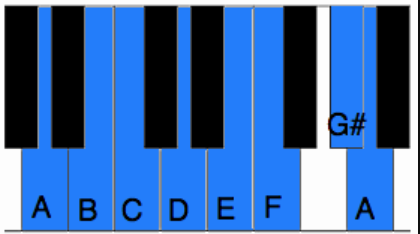
Melodic Minor
the Melodic Minor is a lot different from most other scales in the fact that it is played differently ascending and descending.
Most scales in the list of musical scales are played with the same note going up and then the same note going back down. The Melodic Minor Scale is played one way going up then differently going down.
It is similar to the Harmonic Minor in that it has a sharp seventh note, but it also has sharp 6th note. Look at the image below and you can see both sharp note on the way up. When you come back down, you simple play the notes in the Natural Minor Scale.
This scale requires a lot of practice to really remember it because you have to remember the difference from the ascending and descending pattern.
Ascending Pattern – Root – WS – HS – WS – WS – WS – WS – HS
Descending Pattern – Root – WS – WS – HS – WS – WS – HS – WS


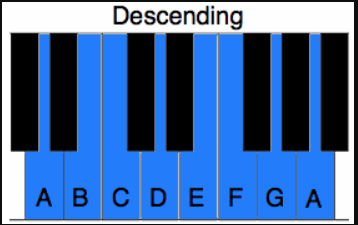
Pentatonic Scale
Using the Pentatonic Scale is easy in most music. It’s a scale that a lot of guitar players use to solo with. This is because that if you are in the key of C and play any note in the C Pentatonic Scale then it will sound good. It’s easy to impress your friends with this scale because any note you play will be right!
This scale is made up of 5 note, hence the prefix PENTA. This is a great scale to use for improvisation and is one of the first you should learn in list of musical scales.
To find this scale you simple find the major scale of the key you want, and use the 1, 2, 3, 5, and 6 notes of the scale.
Here’s a hint…… play any black key on piano keyboard and you are playing a Pentatonic Scale!
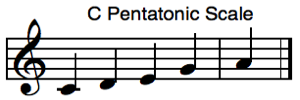
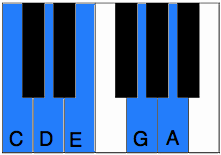
Whole Tone Scale
The whole tone scale is pretty self explanatory. It is one of the easier to remember scales in the list of musical scales.
It is made up of noting but Whole Steps. Each note is separated by a whole tone making this scale easy to remember.

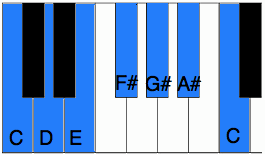
Blues Scale
The Blues Scale is one of the great scales that everyone should know. It is made up of three “blue notes” that gives a song that bluesy sound.
To make this scale you have three flat notes. The 3rd note, 5th note, and 7th note.
Root – 3HS – WS – HS – HS – 3HS – WS


Chromatic Scale
The last scale worth noting in the list of musical scales is the Chromatic Scale. This scale is very easy to remember in the fact that you simply play every note on the piano consecutively.
Just start on any note and then play every note on the piano keyboard in order and you have played the Chromatic Scale. The entire scale is made up of all Half Steps.

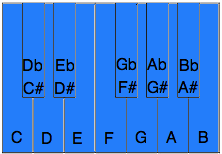
Here we have given a long list of musical scales. Use this list to help memorize the scales that are most commonly used so that you can then implement it into you piano playing.
Each note has a unique sound which can be relevant to certain styles of music.
Go From List of Musical Scales Back to Piano Theory
Back to Home Page
